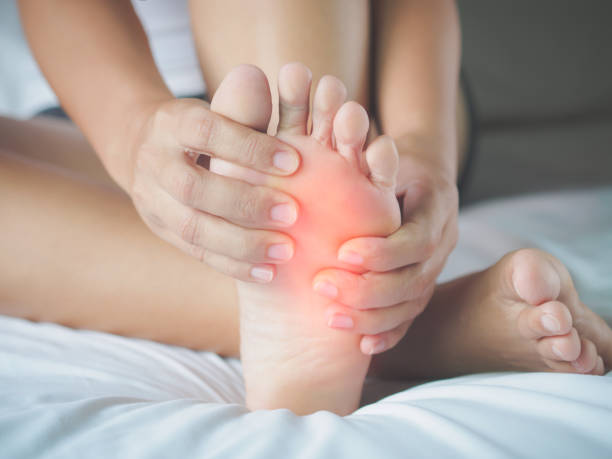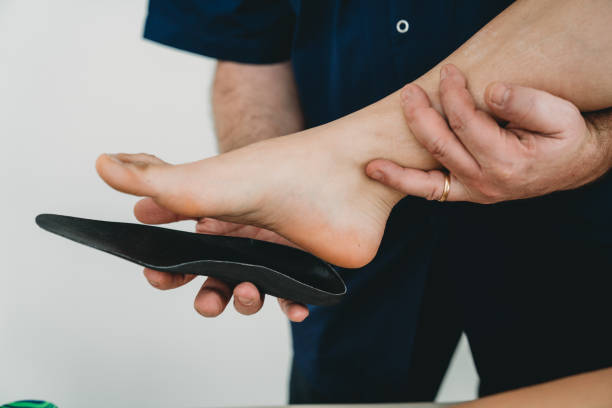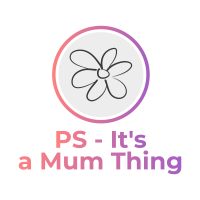Your feet carry you from here to there every day, so when they hurt, it’s important to get them treated right away.
Heel pain typically occurs when the plantar fascia, a band of tough tissue that runs from your heel bone to your toes, becomes irritated or inflamed. Treatment options include icing, stretching exercises, and nonsteroidal anti-inflammatory drugs like aspirin and ibuprofen.

Stretches
Stretches that reduce tight muscles in the foot and calf may help ease heel pain. Tight calf muscles can increase the pressure on the plantar fascia, which runs from the bottom of your heel to the front of your foot. This pressure can cause the ligament to become inflamed, resulting in heel pain. The most common symptom is pain when standing or taking your first few steps in the morning.
Heel spurs, which are abnormal growths of bone on the bottom of your foot, can also cause heel pain. Heel spurs can result from abnormal walking or running patterns, a collapsed arch (flat feet), or over-training with repetitive exercises like sprinting.
Performing calf stretches daily can decrease the tension on your plantar fascia and help relieve heel pain. One simple exercise is to sit with a towel and grab the ends of the towel with your hands. Pull the towel down toward your toes and hold for 30 seconds on each foot. Do this 2-3 times a day. Another effective exercise is to stand with your back leg straight against a wall, and bend your front knee until you feel a stretch in the calf of the affected leg. Then, repeat the same stretch with the other leg. These simple stretches can greatly reduce heel pain.
Ice
Using ice as a heel pain treatment decreases swelling and inflammation. Heel Pain Podiatry in Canberra may recommend applying a cold pack or plastic bag of frozen vegetables on the heel and bottom of the foot several times a day, while also doing heel and foot muscle stretches to reduce tension on the plantar fascia. Over the counter pain relievers like ibuprofen and naproxen can be taken to help with the pain.
X-rays and a physical exam usually determine the cause of heel pain. Inflammation under the heel or behind it (plantar fasciitis) and pain in the back of the ankle that radiates toward the heel (Achilles tendinitis) are common causes of heel pain. Other conditions that can lead to heel pain include Haglund’s deformity (an enlarged bony bump in the back of the heel), Heel spurs, and Sever’s disease (calcaneal apophysitis) which is more common in active children between 8 and 14 who participate in sports that require lots of running and jumping.
Heel spurs are a normal result of the bone responding to traction and pulling forces on the heel, but they can become painful when they develop over time. Podiatrist Monash recommended other treatments for heel spurs include wearing arch supports in the shoes, using a splint at night to stretch the foot and calf muscles, switching from high-impact exercise to low-impact exercise, taking NSAID’s, and using ice.

Over-the-Counter Pain Relievers
Heel pain can make it difficult to move around and do normal daily activities. It can also lead to a sedentary lifestyle, which can cause weight gain and depression. It’s important to seek treatment if heel pain persists.
Podiatrist Gordon can determine the cause of your heel pain and provide effective treatments. An initial assessment will include a discussion of your symptoms and medical history, digital imaging and a manual examination of the foot. In some cases, an MRI or ultrasound may be needed to check for soft tissue damage that X-rays don’t detect.
Over-the-counter nonsteroidal anti-inflammatory medications (NSAIDs) such as ibuprofen can help relieve inflammation and pain. The recommended dose of NSAIDs is up to a maximum of 1,200 milligrams per day.
Plantar fasciitis is a common cause of heel pain. It occurs when the fascia, a tough band of tissue that runs along the bottom of the foot and connects the calf muscles to the heel bone, becomes inflamed. People who run and jump a lot are more prone to developing this overuse injury.
Wearing shoes with good arch support and a cushioned sole can help prevent plantar fasciitis. Using ice on the heel or bottom of the foot can reduce swelling and ease pain. Some patients find relief by wearing a night splint, which helps stretch the foot and calf muscles. A Podiatrist can prescribe custom shoe inserts (orthotics) that can take pressure off the heel.
Physical Therapy
Many people who suffer from heel pain are able to improve their symptoms with home treatment and physical therapy. The most common cause of heel pain is plantar fasciitis. It is caused when the plantar fascia becomes inflamed from overstretching. This condition is most common in athletes and those who spend significant time on their feet without adequate support. Other causes of heel pain include a calcaneal stress fracture, a neuroma, a heel spur or Sever’s disease. Often times, heel pain can be diagnosed with a subjective history, medical imaging or by palpation of the foot and ankle.
Heel pain most commonly occurs under the heel or on the bottom of the foot, but it can also be felt on the outside of the foot or the inside. Heel pain can be dull or sharp and it may feel different during the day. It is often worse when first walking in the morning and after resting the foot for a long period of time.
Keeping the feet warm and dry can help prevent heel pain. Over-the-counter pain relievers, such as ibuprofen and naproxen can decrease inflammation and ease the discomfort. Ice packs can be used to reduce swelling and pain. Stretching exercises and foot supports (heel cups and wedges) that are available without a prescription can help improve foot function and alleviate heel pain.
